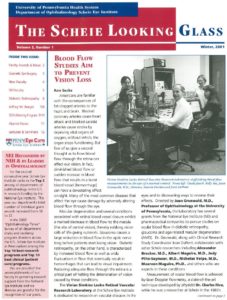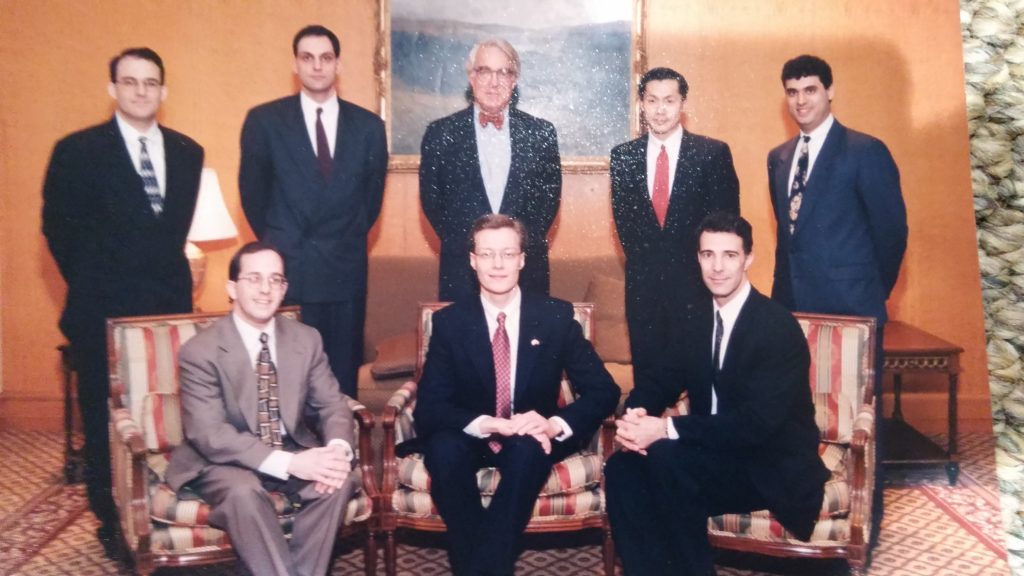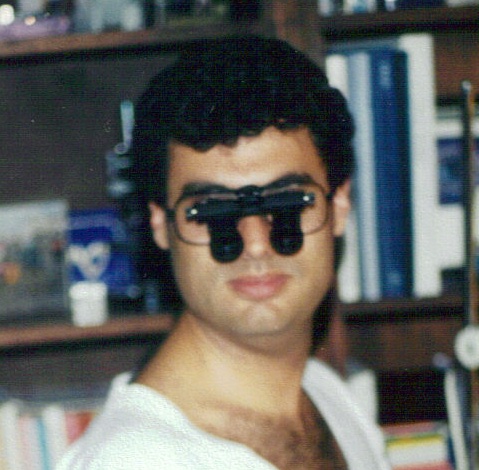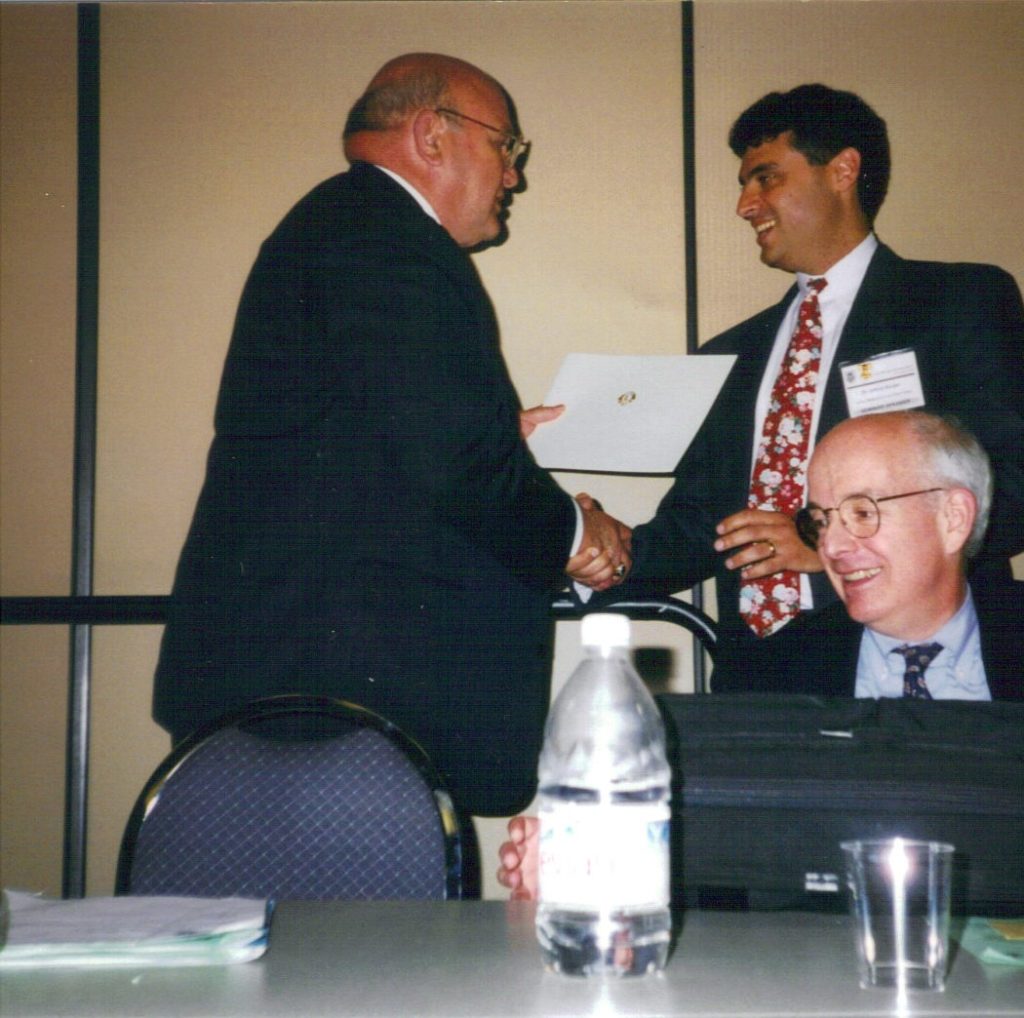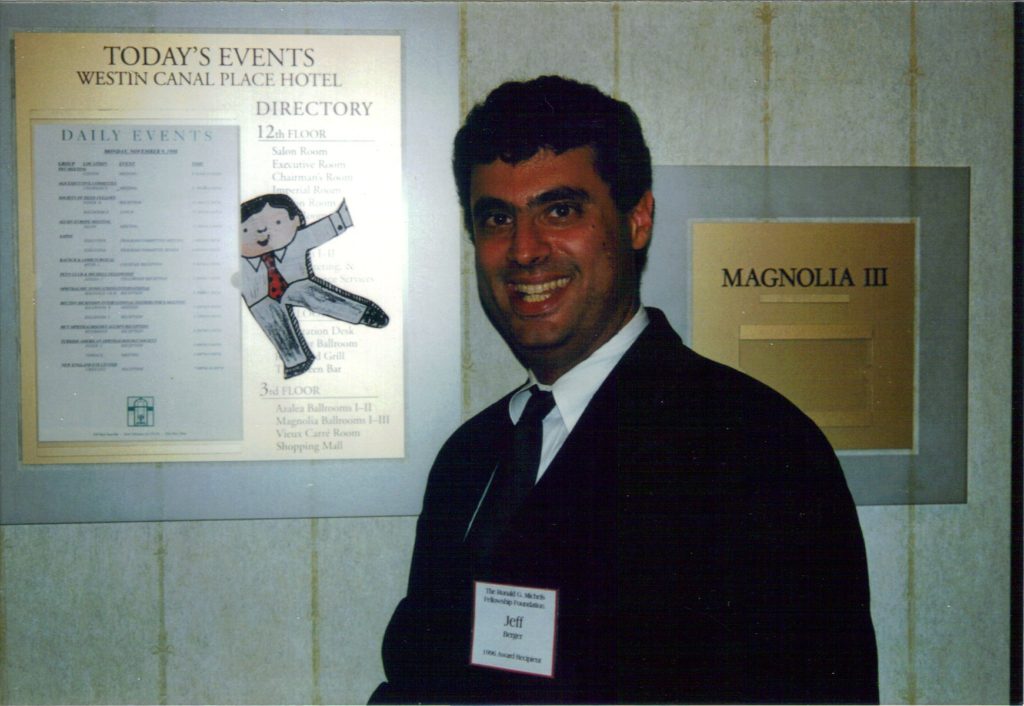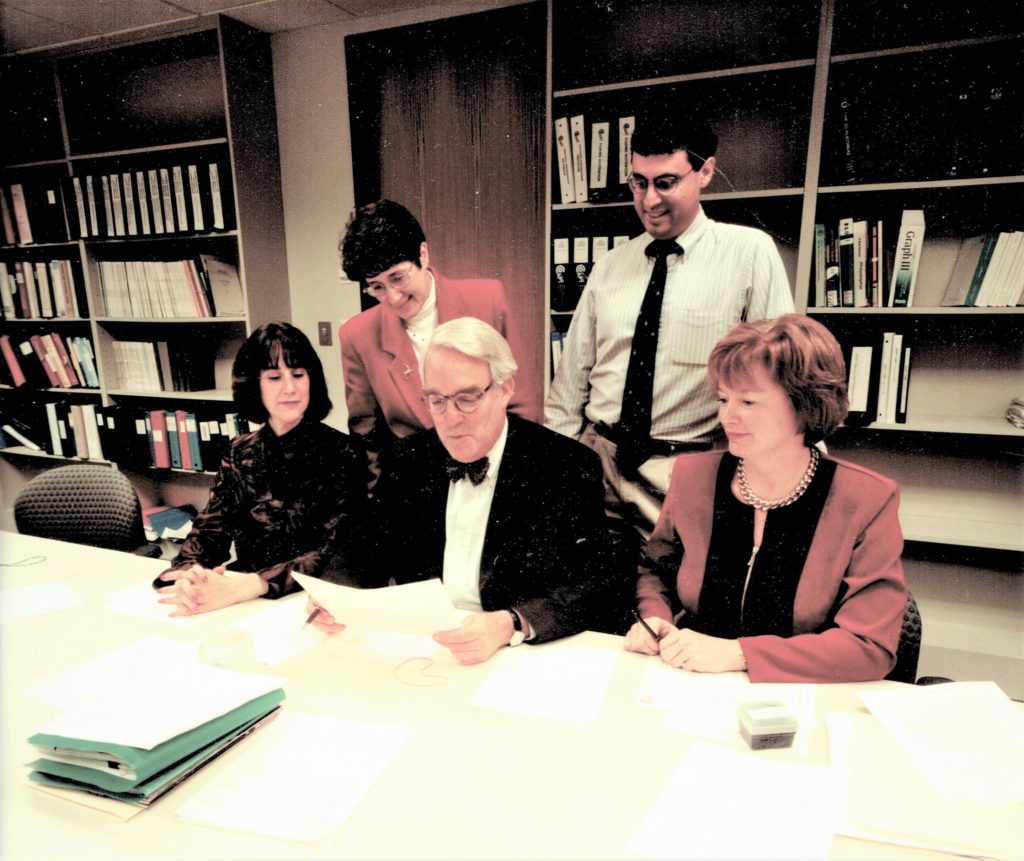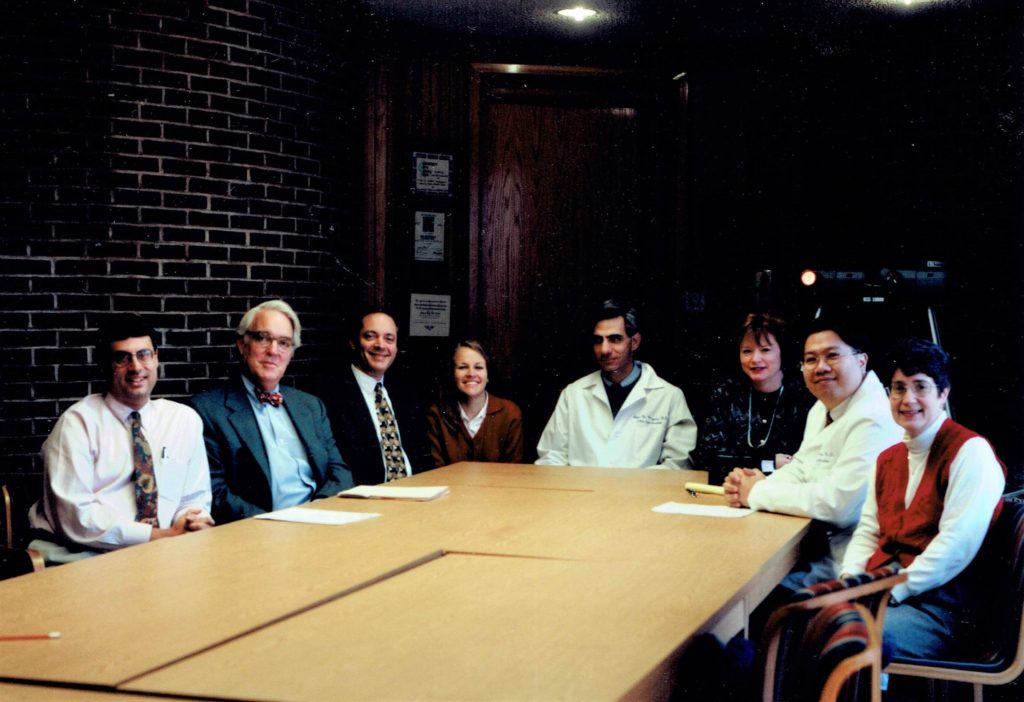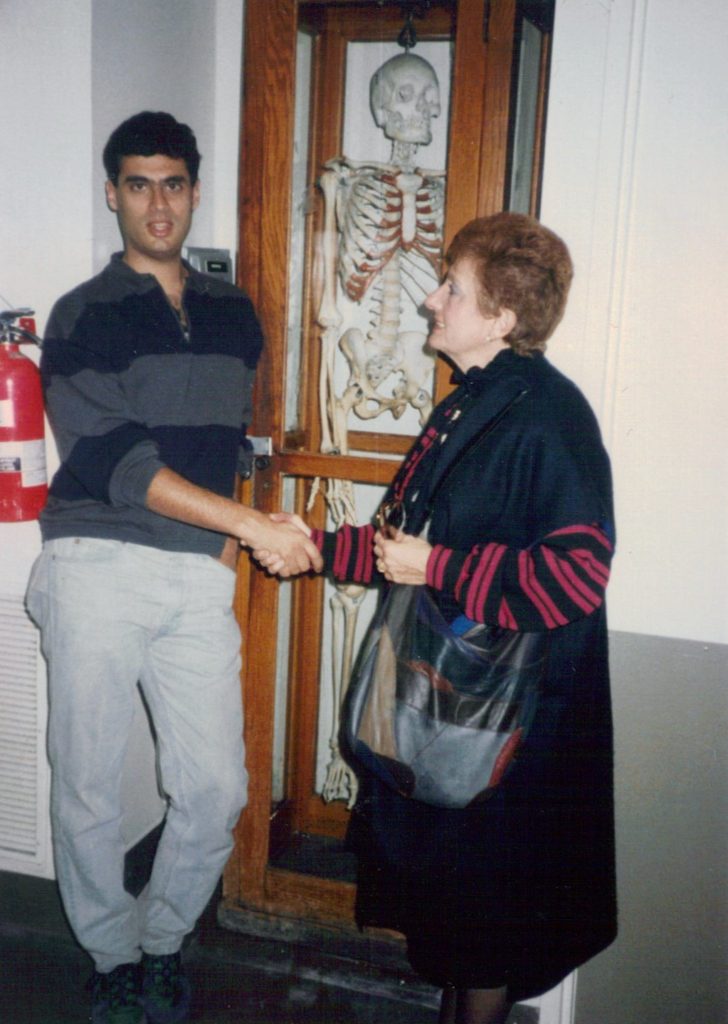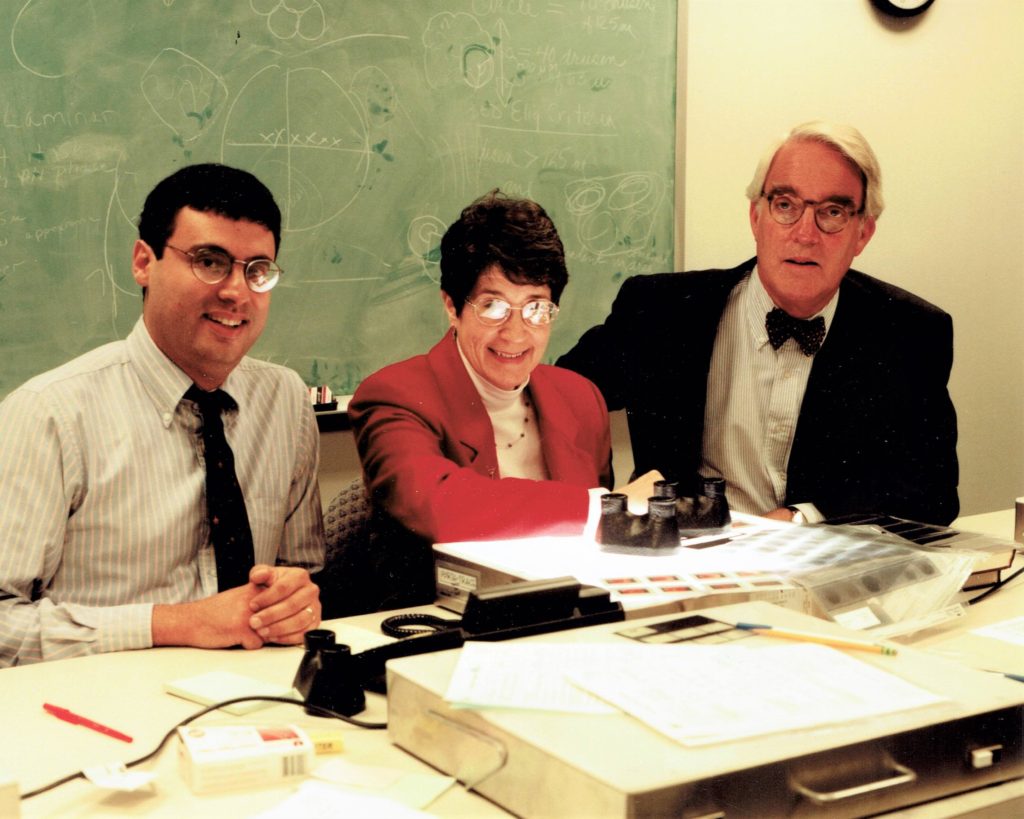The Jeffrey W. Berger Research Scholarship Foundation was formed by Jeff’s family and friends after his untimely death. Although his life was cut short at the very young age of 37, he accomplished a lifetime of innovative and cutting-edge research in the field of ophthalmology. More important was his love of learning, exploring, collaborating, and teaching which were a natural outgrowth of his genuine thirst for knowledge.
Jeff’s career in ophthalmology began and ended at the Scheie Eye Institute of the University of Pennsylvania. The Scheie family had been an integral part of his life and they have continued to honor Jeff yearly with an annual lectureship in his memory. Scheie also renamed their annual Golden Apple Award which was given to the doctor chosen as the best resident instructor, which is known as the Jeffrey W. Berger Golden Apple Resident Teaching Award.
.
Our foundation is an independent 501(c)(3) charitable organization which was created with the intent to support ophthalmologic research to continue Jeff’s work and honor his name. It has partnered with Scheie since 2005 by providing annual scholarships to medical students interested in pursuing serious ophthalmologic research. Each year, we choose one or two promising medical students whom we believe have the potential to pursue careers as clinician/scientists: combining ophthalmologic research with clinical care, as this was Jeff’s ultimate career goal. Not only can they emulate Jeff’s achievements in the world of ophthalmology, but they also learn about him as a caring physician, a dedicated instructor and a collaborative colleague.
.
In 2021, we introduced the Scheie Hadassah InterNational Exchange (SHINE) Program to provide opportunities for students at Scheie to do research at Hadassah Hospital in Jerusalem and students at Hadassah to do research at Scheie.
.
Since the creation of this foundation, so many have shared their memories of Jeff and the impact he had on their lives and their careers. Each year, we are amazed to find another brilliant speaker for our annual lecture at the Scheie Eye Institute who was impacted by Jeff and his work. And in turn, we pass this on to the younger generation of upcoming ophthalmologists as we provide scholarships for them to pursue serious ophthalmologic research. In this way, Jeff’s love for research and teaching continues.At the time of his passing, Jeff was Assistant Professor of Ophthalmology (Retina Service) at the University of Pennsylvania and Director of the Computer Vision Laboratory at Penn’s Scheie Eye Institute. While his life was cut short at the age of 37, he managed to achieve extraordinary accomplishments professionally while never sacrificing that which was most important in his personal life. His professional successes seemingly came easily as a result of his natural curiosity and thirst for knowledge and never stood in the way of the rich personal life he enjoyed with his family and community.
.
Jeff was born in 1963 in Flushing, New York, which he was always proud to refer to as “Home of the Mets”. He was the youngest of three children and raised in a loving and nurturing environment. He was fortunate to have parents who prioritized education and despite the hardship, were willing to provide the “best” education for him to succeed in both the secular world and the Jewish community which was of utmost importance to them. His mother always emphasized that whatever he did in life was to be for G-d and for mankind. It was not enough to be smart and educated but he was always told to be “courteous and respectful” to everyone. These were lessons he carried with him throughout his life.
.
It was not long before teachers and mentors recognized his brilliance. It was clear to classmates and teachers alike that he was gifted and would achieve great things in life, but he was also known for his good nature, humility and ability to work with others. In 9th grade he had his first publication. He played chess and bridge in high school and was known by the faculty as an exceptional student. He worked on the school yearbook and was admired by his peers. Jeff loved to reminisce about the summer of 1980 when he went to “math camp” which was actually a program at Hampshire College Summer Math Program which was funded by the National Science Foundation.
.
Jeff went to Princeton as an undergraduate where he thrived academically and socially. At Princeton his interest in math led him to a major in mechanical engineering. It was in his Junior year that his interest in vision and light was sparked. In one of his personal statements Jeff wrote, “As a Princeton Junior, I investigated the interactions between laser light and turbulent fluid flow and contributed to the development of a laser diagnostic system. In my senior year, I combined my interests in vision, optics and microelectronics by designing and constructing an interface to a microprocessor-based reading aid for the blind”.
.
Upon graduating from Princeton in 1985, Jeff pursued his scientific interests at University of Pennsylvania where he began his graduate work in Bioengineering under Prof Alan Laties, M.D., Ph.D. at Scheie Eye Institute, who had a tremendous impact on his career. He discovered that he could use his strengths in math and science in the medical field and apply them directly to patient care. Two years into his graduate work, after receiving a master’s degree in Bioengineering (1987), he realized a joint M.D., Ph.D. would be the best way for him to combine his interests and talent.
.
Following his interests in the interaction of light and matter he began investigating the interaction of light with biological and non-biological materials, from small molecules to whole organs, using theoretical, computational, and experimental methods. He ended up studying spectroscopy with Jane Marie Vanderkooi, Ph.D. in the Biophysics graduate group at Penn. His thesis entitled “Photophysics and Photochemistry of Eye Lens Crystallines” earned him a Ph.D. in Biophysics in 1991. He earned his medical degree from Penn in 1992.
.
After a Transitional Internship at Albert Einstein Medical Center in Philadelphia, Jeff’s interests in the biophysical approaches to problems in ophthalmology led him to an Ophthalmology residency at Massachusetts Eye & Ear Infirmary, Harvard Medical School. His longstanding interests in light, lasers, vision and optics led him to pursue clinical, teaching and research as an interdisciplinary scientist in an academic setting.
.
As an ophthalmology resident, Jeff contributed toward the development and refinement of erbium: YAG laser-assisted vitreoretinal surgery. His work focused on understanding the thermal and acousto-mechanical sequelae of the laser-tissue interaction. His experimental analytical and modelling studies contributed towards optimization strategies for energy delivery during Er: YAG laser-assisted surgery. Upon completion of his residency, it was clear that his strong training in both physical science and clinical ophthalmology prepared him to approach problems in ophthalmic biophysics as he was able to draw on his broad and deep scientific training to investigate areas of direct clinical interest.
.
Jeff returned to Scheie to pursue a clinical fellowship in Retinal Diseases and Vitreoretinal Surgery. He believed that vitreoretinal surgical technique was still in its infancy and the development and refinement of virtual-reality associated technologies would fuel an explosive change in vitreoretinal surgical technique. He believed that his training in engineering, biophysics and optical sciences combined with this clinical training would allow him to contribute significantly to the evolution of invasive and non-invasive approaches to vitreoretinal disease.
.
Jeff’s second home was at Scheie where he blossomed until his untimely death. His accomplishments upon returning to Scheie as a Fellow and then assistant professor of ophthalmology in the Retina Service were extraordinary. He both founded and directed the Computer Vision Laboratory, an enterprise funded in part by his Research to Prevent Blindness Career Development Award and in part by his Mentored Clinician Scientist Award from the National Eye Institute. He also served as principal investigator of the Reading Center for the Complications of AMD (age-related macular degeneration) Prevention Trial (CAPT); a multicenter clinical trial funded by the National Eye Institute.
.
In addition to his clinical practice and his position as chief of the Retina Service at the Philadelphia VA Medical Center, Jeff was involved in collaborative research with ophthalmologic investigators around the world. Jeff had developed a system for evaluating digital fundus images applicable to patient care and for use in randomized clinical trials. His extensive bibliography also included peer-reviewed publications in the engineering literature. He was an expert on laser tissue interactions, optical imaging and retinal diseases. He was the principal editor of the comprehensive textbook, AGE-RELATED MACULAR DEGENERATION (Mosby Inc;1998). His many publications and patents are listed elsewhere on this site.
.
For the faculty at Scheie he was a valued and respected colleague. To fellows, residents and medical students, he was an inspiring teacher and mentor.
.
Jeff led a very full and meaningful life outside the field of ophthalmology as well. He was a loving husband to Karen and father to their 3 children, Adina, Tamar and Joe. He left behind adoring parents, Jack and Eve Berger and siblings, Arlene and Alan along with a large and loving extended family. He was active in his synagogue and community in Cherry Hill, New Jersey.
.
In May 2000, less than a year before his passing, he was privileged to lecture at the combined meeting of the 6th Mediterranean Ophthalmological Society and the Michaelson Symposium on Ocular Circulation and Neovascularization as well as at the Technion in Haifa Israel and in Jerusalem. This was most exciting for Jeff both professionally and personally because he had always had a deep connection to Israel. After this visit, he was intent on finding more ways to collaborate with physicians and researchers in Israel with the goal of visiting more often.
.
This love of Israel was instilled in Jeff’s children and now, 20 years later, they are all living in Israel along with Karen, who has remarried to Elia Weixelbaum. As a way of helping Jeff realize his dream of future connections in Israel, we have initiated an exciting new project with the ophthalmology department at Hadassah Hospital in Jerusalem which is discussed elsewhere on this site.
- Age-related Macular Degeneration (Hardcover text) Stuart L. Fine, MD ; Jeffrey W. Berger, MD, PhD; Maureen G. Maguire, PhD Publisher – Mosby (St. Louis), 1998
- When the P’s are not ERRLA: A practical front-line approach to pupil abnormalities Jeffrey W. Berger, MD, PhD Emergency Eye Care Insight, Vol 1, 1994
- Er:YAG laser drilling of cataractous lens: predicting the ablation rate with a simple model Jeffrey W. Berger, MD, PhD; Seon-Ho Kim, MD, PhD; Kevin J. LaMarche, BS, COA; Donald J. D’Amico, BS, COA; Jonathan H. Talamo, MD Proc SPIE 1995; 2393 (Biomedical Optics: Ophthalmic Technologies V): 148-159
- Design Considerations for a Computer-Vision-Enabled Ophthalmic Augmented Reality Environment Jeffrey W. Berger, MD, PhD; Michael E. Leventon, PhD; Nobuhiko Hata, PhD; William Wells III, PhD; Ron Kikinis, MD Lecture Notes in Computer Science, Springer-Verlag 1997; 1205: 399-408
- Fundus image change analysis: geometric and radiometric normalization David S. Shin, MD; Richard S. Kaiser, MD; Michael S. Lee, MD; Jeffrey W. Berger, MD, PhD Proc SPIE 1999;3591:129-136
- Quantitative spatiotemporal image analysis of fluorescein angiography in age-related macular degeneration Jeffrey W. Berger, MD, PhD Proc SPIE 1998;3246:48-53
- Variability in fluorescein angiography interpretation for photodynamic therapy in age-related macular degeneration Richard S. Kaiser, MD; Jeffrey W. Berger, MD, PhD; George A. Williams, MD; Michael J. Tolentino, MD; Albert M. Maguire, MD; Judith Alexander, BA; Bojidar Madjarov, MD; Raymond M. Margherio, MD Retina. 2002 Dec;22(6):683-90. doi: 10.1097/00006982-200212000-00001
- Augmented reality fundus biomicroscopy: a working clinical prototype Jeffrey W. Berger, MD, PhD; Bojidar Madjarov, MDArch Ophthalmol. 2001 Dec;119(12):1815-8. doi: 10.1001/archopht.119.12.1815
- Laser burn intensity and the risk for choroidal neovascularization in the CNVPT Fellow Eye Study Richard S. Kaiser, MD; Jeffrey W. Berger, MD, PhD; Maureen G. Maguire, PhD; Allen C. Ho, MD; Noreen B. Javornik, MS; and the Choroidal Neovascularization Prevention Trial (CNVPT) Study Group Arch Ophthalmol. 2001 Jun;119(6):826-32. doi: 10.1001/archopht.119.6.826
- Mosaicking and enhancement of slit lamp biomicroscopic fundus images Jane Asmuth, Bojidar Madjarov, Paul Sajda, Jeffrey W Berger, MD, PhD Br J Ophthalmol. 2001 May;85(5):563-5. doi: 10.1136/bjo.85.5.563
- Computer-assisted quantitation of choroidal neovascularization for clinical trials Jeffrey W. Berger, MD, PhD; Jonathan Yoken, MD Invest Ophthalmol Vis Sci. 2000 Jul;41(8):2286-95
- Computerized stereochronoscopy and alternation flicker to detect optic nerve head contour change Jeffrey W. Berger, MD, PhD; Tushar R. Patel, MD; David S. Shin, MD; Jody R. Piltz, MD; Richard A. Stone, MD Ophthalmology. 2000 Jul;107(7):1316-20. doi: 10.1016/s0161-6420(00)00157-3
- Grading, image analysis, and stereopsis of digitally compressed fundus images Michael S. Lee, MD; David S. Shin, MD; Jeffrey W. Berger, MD, PhD Retina. 2000;20(3):275-81
- Wavelength considerations for laser prophylaxis in AMD Jeffrey W. Berger, MD, PhD 10.1016/s0161-6420(00)00052-x
- Automated, real time extraction of fundus images from slit lamp fundus biomicroscope video image sequences Bojidar D. Madjarov, MD; Jeffrey W. Berger MD, PhD Br J Ophthalmol. 2000 Jun;84(6):645-7. doi: 10.1136/bjo.84.6.645
- Age-related macular degeneration Stuart L. Fine, MD; Jeffrey W. Berger, MD, PhD; Maureen G. Maguire, PhD; Allen C. Ho, MD N Engl J Med. 2000 Feb 17;342(7):483-92. doi: 10.1056/NEJM200002173420707
- An intelligent, interactive platform for ophthalmic teaching, telemedicine, and telecollaboration: design considerations and prototype construction Roopa Hariprasad, MBBS, DGO; David S. Shin, MD; Jeffrey W. Berger, MD, PhD Stud Health Technol Inform. 1999;62:124-9
- Computer-vision-enabled augmented reality fundus biomicroscopy Jeffrey W. Berger, MD, PhD; David S. Shin, MD Ophthalmology. 1999 Oct;106(10):1935-41. doi: 10.1016/S0161-6420(99)90404-9
- Computer-assisted, interactive fundus image processing for macular drusen quantitation David S. Shin, MD; Noreen B. Javornik, MS; Jeffrey W. Berger, MD, PhD Ophthalmology. 1999 Jun;106(6):1119-25. doi: 10.1016/S0161-6420(99)90257-9
- Quantitative image sequence analysis of fundus fluorescein angiography Jeffrey W. Berger, MD, PhD Ophthalmic Surg Lasers. 1999 Jan;30(1):72-3
- Erbium-YAG laser ablation: the myth of 1-micron penetration Jeffrey W. Berger, MD, PhD Arch Ophthalmol. 1998 Jun;116(6):830-1. doi: 10.1001/archopht.116.6.830
- The magnitude of the bubble buoyant pressure: implications for macular hole surgery Jeffrey W. Berger, MD, PhD; Alexander J. Brucker, MD Retina. 1998;18(1):84-6; author reply 86-8. doi: 10.1097/00006982-199801000-00020
- Modeling of erbium: YAG laser-mediated explosive photovaporization: implications for vitreoretinal surgery Jeffrey W. Berger, MD, PhD; Donald J. D’Amico, MD Ophthalmic Surg Lasers. 1997 Feb;28(2):133-9
- Thermal modelling of micropulsed diode laser retinal photocoagulation Jeffrey W. Berger, MD, PhD Lasers Surg Med. 1997;20(4):409-15. doi: 10.1002/(sici)1096-9101(1997)20:4<409::aid-lsm6>3.0.co;2-u
- Temperature measurements during phacoemulsification and erbium:YAG laser phacoablation in model systems Jeffrey W. Berger, MD, PhD; Jonathan H. Talamo, MD; Kevin J. LaMarche, BS, COA; Seon-Ho Kim, MD, PhD; Robert W. Snyder, MD, PhD; Donald J. D’Amico, MD; George Marcellino, PhD J Cataract Refract Surg. 1996 Apr;22(3):372-8. doi: 10.1016/s0886-3350(96)80253-7
- Measurement and modeling of thermal transients during Er:YAG laser irradiation of vitreous Jeffrey W. Berger, MD, PhD; Thomas W. Bochow; MD; Jonathan H. Talamo, MD; Donald J. D’Amico MD Lasers Surg Med. 1996;19(4):388-96. doi: 10.1002/(SICI)1096-9101(1996)19:4<388::AID-LSM2>3.0.CO;2-O
- Pediatric orbital pseudotumor: case report and review of the literature Jeffrey W. Berger, MD, PhD; Peter A. D. Rubin, MD; Frederick A. Jakobiec, MD, DSc Int Ophthalmol Clin. 1996 Winter;36(1):161-77. doi: 10.1097/00004397-199603610-00017
- Laser energy and dye fluorescence transmission through blood in vitro Jeffrey W. Berger, MD, PhD Am J Ophthalmol. 1995 Sep;120(3):404-5. doi: 10.1016/s0002-9394(14)72179-8
- The anaerobic photolysis of lens alpha-crystallin: evidence for triplet state mediated photodamage Jeffrey W. Berger, MD, PhD; Jane M. Vanderkooi, PhD Photochem Photobiol. 1990 Oct;52(4):855-60. doi: 10.1111/j.1751-1097.1990.tb08693.x
- Excited triplet states used to study biological macromolecules at room temperature Jane M. Vanderkooi, PhD; Jeffrey W. Berger, MD, PhD Biochim Biophys Acta. 1989 Aug 17;976(1):1-27. doi: 10.1016/s0005-2728(89)80185-9
- Characterization of lens alpha-crystallin tryptophan microenvironments by room temperature phosphorescence spectroscopy Jeffrey W. Berger, MD, PhD; Jane M. Vanderkooi, PhD Biochemistry. 1989 Jun 27;28(13):5501-8. doi: 10.1021/bi00439a027
- Phosphorescence measurements of calf gamma-II, III, and IV crystallins at 77 and 293 K Jeffrey W. Berger, MD, PhD; Jane M. Vanderkooi, PhD; Daniel H. Tallmadge; Raymond F. Borkman Exp Eye Res. 1989 May;48(5):627-39. doi: 10.1016/0014-4835(89)90005-5
- Brownian dynamics simulations of intramolecular energy transfer Jeffrey W. Berger, MD, PhD; Jane M. Vanderkooi, PhD Biophys Chem. 1988 Jul 15;30(3):257-69. doi: 10.1016/0301-4622(88)85021-x
.

.
The following are links to some of the obituaries for Jeff at the time of his passing in 2001..
JAMA Ophthalmology.
University of Pennsylvania.
The Winter 2001 publication of The Scheie Looking Glass (starting on page 7) has an obituary for Jeff..
